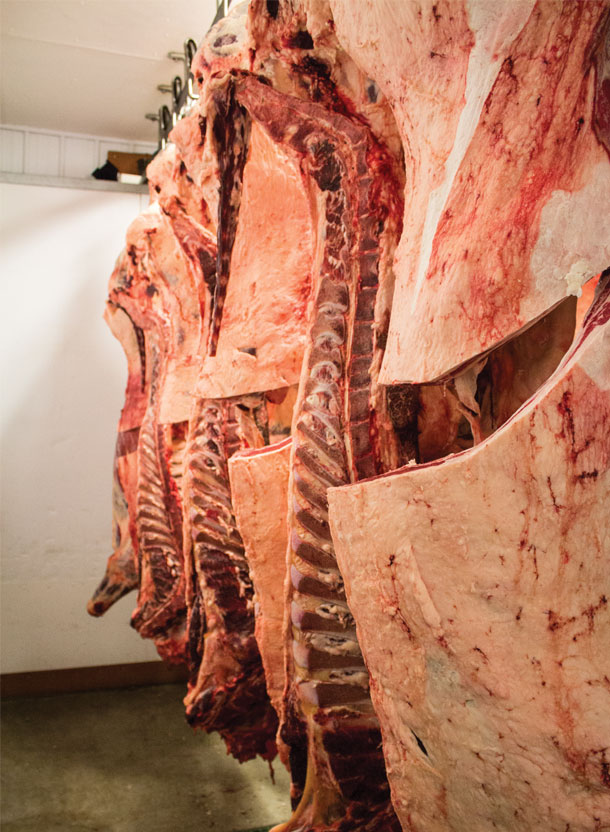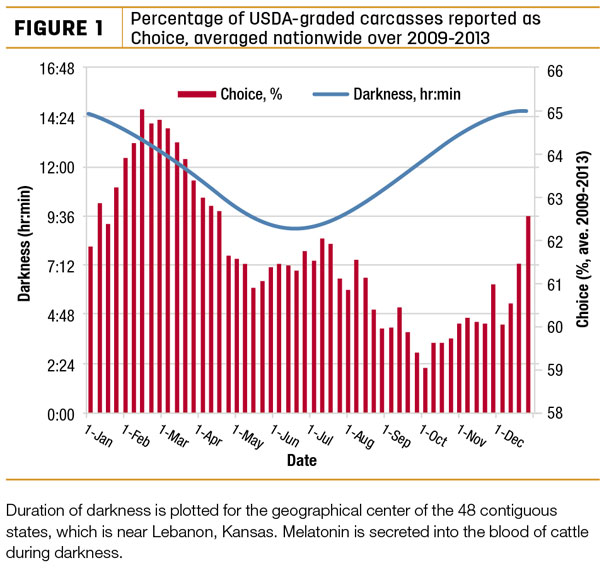Marbling is the intramuscular fat that accounts for juiciness and flavor in cooked beef. This beef quality variable has received long-standing attention from the beef cattle industry and the animal science community. Consequently, much has been written about factors that influence marbling score.
With regard to approaches that enhance marbling score, only time on feed and genetic selection have been established. The heritability estimate for marbling is 0.45, which is the foundation for those breeds and breeders that have used this variable as a selection criterion.
 Marbling is the intramuscular fat that accounts for juiciness and flavor in cooked beef. Thus far, only time on feed and genetic selection have been found to enhance marbling score. Photo by Ray Merritt
Marbling is the intramuscular fat that accounts for juiciness and flavor in cooked beef. Thus far, only time on feed and genetic selection have been found to enhance marbling score. Photo by Ray Merritt Yet this heritability value suggests that environmental factors could have a cumulatively greater impact on marbling score.
The idea
Our interest in marbling stems from our observation in the late 1980s. We observed that calf-fed Holstein steers harvested in March and April resulted in a higher percentage of Choice carcasses than steers harvested in July (80 percent versus 65 percent – unpublished data).
All steers were harvested at 1,100 pounds, had been fed the same energy-dense diet and received the same anabolic implant program.
This observation prompted us to formulate the hypothesis that short day length increases deposition of fat as marbling, and that this effect should be recognized when the harvest date follows a protracted period of short day length. The idea was too far-fetched to write about then; data were needed.
Having conducted some research, we present the case here for others to ponder.
Indirect support for the hypothesis
Photoperiod affects lactation, puberty and hair growth in cattle. Long photoperiod increases milk production, which is why dairy freestall barns have continuous lighting. Heifers coming to their pubertal estrus display this estrus at a younger age when photoperiod is increasing as they attain puberty. Fall-born heifers reach puberty at an earlier age than spring-born heifers.
Short photoperiod stimulates hair growth. Club calf showmen have taken advantage of this for years.
We have also confirmed that eight versus 16 hours of illumination at 72ºF stimulates hair growth.
Seasonal effects on marbling score have been reported. Terry Mader’s group at University of Nebraska – Concord reported that yearling heifers fed during December to April had greater marbling scores than similar heifers fed during June to September. Across 2009 to 2013, USDA Choice grade percentage was highest in February and March (Figure 1).
 However, data for 2014 to 2016 indicate that the relationship of Choice grade percentage with season has changed in recent years.
However, data for 2014 to 2016 indicate that the relationship of Choice grade percentage with season has changed in recent years.
If the seasonal effect is trustworthy, the magnitude of its effect is not large, only affecting Choice percentage by 4 to 5 percentage units (Figure 1). In order to detect a day length effect, one needs large numbers of finished cattle. Genetic uniformity among those cattle would aid the sensitivity of the experimental design.
We obtained the corporate quality grade data from Packerland Packing Company, a Holstein steer packer, for 1997 and analyzed those results within 100-pound carcass weight and quality grade categories and by month of harvest.
The temporal profile of Choice percentage did not mirror the USDA-reported pattern in Figure 1, and the results did not support an interpretation based on day length. This result was disappointing because we felt this large dataset represented the best possible dataset of genetically uniform finished steers.
Proposed mechanism of action
We believe that melatonin could be the endocrine signal by which darkness stimulates intramuscular fat deposition. Melatonin is secreted by the pineal gland during periods of darkness.
Allen Tucker’s group at Michigan State University studied the effect of photoperiod on plasma melatonin concentrations and went so far as to feed melatonin to finishing beef heifers to study its effect on composition of weight gain.
Steve Zinn and co-workers reported increased rib primal fat content and increased longissimus fat content in heifers fed melatonin. They did not report marbling score. We were heartened to read that melatonin fed as a diet additive resulted in a spiked melatonin concentration in blood.
Their source of melatonin was a pharmaceutical supply house, which is an expensive source.
Melatonin
Two pieces of information encouraged us that experimentation with melatonin in finishing cattle could be feasible. We learned that melatonin has been patented for use as an implant for mink to improve pelt fur quality. However, this source of melatonin is also very expensive and short-lived, making it unsuitable for commercial use in a feedyard even if such use were to be approved by the FDA.
The second revelation was that melatonin is available in large, inexpensive quantities from pharmaceutical companies in China. We procured melatonin from Luotian Xingpusheng Pharmaceutical Co. Of course, there was concern for the purity of this melatonin. We submitted a sample of this source to our campus biotechnology center for liquid chromatography-mass spectrometry analysis.
The results of that analysis confirmed that melatonin was the dominant chemical species in the white powder.
Melatonin is categorized by the FDA as a dietary supplement, not a drug. Melatonin is not considered a drug since it is a naturally occurring substance and is designated “generally recognized as safe.” Our review of the literature did not reveal any information on melatonin concentration in muscle/meat tissue.
Given this status and with our evidence of chemical purity, the USDA-FSIS provided us with slaughter permits so that our finished steers and heifers could enter the domestic food chain.
Experimental evidence
Our research thus far has been very applied in nature. We have finished steers and heifers on dosages of dietary melatonin that were zero, 20, 100 or 200 milligrams per head daily for durations of 112 to 161 days, spanning either the winter or summer solstice. In all trials, we fed the pens once daily, allowing at least one hour of daylight to elapse before the daily feeding.
Urine sample analysis revealed excretion of 6-hydroxymelatonin sulfate in a dietary dose-dependent relationship.
This is the expected liver metabolite of melatonin, suggesting that melatonin survived passage through the rumen and was absorbed as melatonin from the digestive tract. However, we did not find any increase in hair growth due to melatonin supplementation. More importantly, melatonin did not affect marbling score or ether-extractable fat from ribeye-facing slices.
In heifers, melatonin improved gain efficiency (100 mg daily, 3 percent; 200 mg daily, 8 percent) when fed from Oct. 22 to Feb. 11. In steers, season of the trial did not affect the results; however, melatonin increased subcutaneous fat depth.
Questions remaining
While there is some support for the hypothesis, the results collected to date are inconclusive. Although dietary melatonin is apparently absorbed, it is not altering hair growth. This raised the question of whether our methods are altering metabolism in cattle so as to induce the biological consequences of short day length.
We were unable to determine blood concentrations of melatonin, so we do not know how the administered dosages compare to the nighttime concentrations of melatonin. It is conceivable that one could accentuate the potency of dietary melatonin by encapsulating it to protect it from rumen microbial degradation.
In conclusion, we wish to advance nighttime darkness for consideration as a factor that influences marbling score. Our hypothesis is testable, and there is a prospect for new knowledge that could be economically important.







